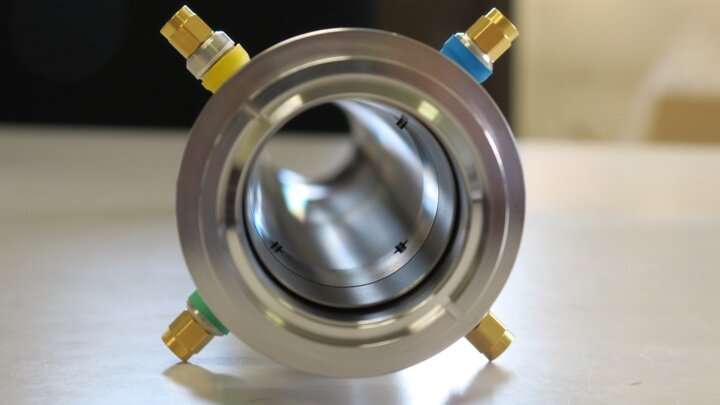Direct observation of the electron and positron capture process

Positrons are anti-particles of electrons. At SuperKEKB B-Factory (SuperKEKB), they are produced in copious amounts and smashed into electrons at world-record luminosity. By studying the hundreds of decay patterns of B mesons and anti B mesons in these collisions, physicists investigate the secrets of matter and antimatter imbalance and traces of other exotic particles beyond the standard model. To improve the collision rate, increasing the positron intensity is one of the key elements in this experiment.
Positrons can be produced by bombarding high-current and high-energy electrons into a target made of heavy metal, such as tungsten. However, equal numbers of electrons are produced in the target and they are simultaneously captured by electric and magnetic forces in the positron capture section, which is subsequently located after the target. Positrons are separated from electrons by magnetic forces just after the capture section.
It is very difficult to independently detect positrons and electrons at the same time in the capture section. There are three reasons measurement is difficult in the capture section. First, there is almost no space to install any beam monitors; second, in the radiation environment, the target is close to the instrumentation devices; and third, the time interval between positrons and electrons is very short because they pass almost simultaneously through the capture section.
A team led by Prof. Tsuyoshi Suwada of KEK successfully installed a new type of beam monitors into the SuperKEKB positron source. "The idea is to use a wideband beam monitor with a simple rod antenna," says Suwada. "This idea is well-known in radio-frequency wave detection techniques. It was successfully experimented with the use of charged particle beams in high-energy accelerators, such as electron and positron beams for the first time at KEK. It turns out that an electron (or positron) beam clearly precedes a positron (or electron) beam with some time interval in time domain in the capture section."
"Interestingly, what we found in experiments is that the time interval between electrons and positrons intricately variates in the range of 20 to 280 ps on average, and their traveling order is interchanged depending on the operation condition of the capture section. At the capture phase of 0 deg, the electrons with minus signal polarity clearly precedes the positrons with plus signal polarity, and the time interval is 137 ps. At the capture phase of 180 deg, the positrons with plus signal polarity clearly precedes the electrons with minus signal polarity, and the time interval is 140 ps.
"It turns out that the time interval between the electrons and positrons variates intricately in time domain and the traveling order is interchanged at the capture phases of 50 and 230 degrees," adds Suwada. Applied to the SuperKEKB, the enhanced capture efficiency of positrons helped the SuperKEKB improve its world-record luminosity.
"We believe that this new beam monitor could be applied in the next-generation of B-factories and future e+e- linear colliders," Suwada concludes. This work has been done through the collaborative efforts of Dr. Muhammad Abdul Rehman of KEK (present affiliation is IHEP).
This research was published last month in Scientific Reports.
More information: Tsuyoshi Suwada, Direct observation of positron capture process at the positron source of the superKEKB B-factory, Scientific Reports (2022). DOI: 10.1038/s41598-022-22030-5
Journal information: Scientific Reports
Provided by High Energy Accelerator Research Organization/KEK




















